Since micro-organisms and food are intrinsically associated with each other. This article will describe the facts regarding spoilage bacteria and its examples.
Food spoilage can be defined as biochemical processes aided by microorganisms, especially bacteria that deteriorate the quality of the food. Food contains a nutritional value that acts as a medium for bacteria to grow and proliferate.
Some spoilage bacteria examples are listed below.
- Brochothrix spp.
- Carnobacterium spp.
- Lactobacillus spp.
- Pediococcus spp.
- Streptococcus spp.
- Lactococcus spp.
- Leuconostoc spp
- Kurthia spp.
- Weissella spp.
- Bacillus sporothermodurans
- Bacillus amyloliquefaciens
- Geobacillus stearothermophilus
- Bacillus coagulans
- Alicyclobacillus acidoterrestris
- Clostridium butyricum
- Clostridium sporogenes
- Clostridium putrefaciens
- Desulfotomaculum nigrificans
- Brucellae spp.
- Campylobacter spp.
- Salmonellae spp.
- Escherichia spp.
Types of spoilage bacteria
The spoilage bacteria can be either non-spore-forming bacteria or spore-forming bacteria.
Spore-forming bacteria are a major threat to thermally treated foods. They can thrive in low acidic foods which are processed by heat while others can survive in refrigerated foods due to their psychrotrophic nature. Both chemical and physical procedures cannot fully eliminate the spores which activate at certain environmental conditions such as low pH, and sub-optimal heat.
The non-spore-forming spoilage bacteria examples are as follows:
Brochothrix spp.
It is a common spoilage bacterium which mostly invade chilled raw meat products. The two important members of this genus Brochothrix are B. thermosphacta and B. campertris. B. thermosphacta largely present in chilled raw meat products of pork, lamb and fish. It is a Gram-positive rod shaped and facultative anaerobic bacteria.
Since these are psychrotrophs, they can thrive at refrigeration temperature ranges from 0° C to 30 °C with pH range 5-9. The spoilage enhances greatly at anaerobic condition where it produces lactic acid and ethanol aided by increased CO2 levels.
Carnobacterium spp.
This Gram-positive lactic acid bacterium (LAB) often flourishes at vacuum or modified environment in packaged meat, seafoods as well as in dairy products. The members of this genus are Carnobacterium divergens and Carnobacterium maltaromaticum. These species are tolerant to freezing temperature and present in high pressure processed, frozen seafoods and meat.
Lactobacillus spp.
The order Lactobacillales includes the most versatile spoilage bacteria which are Gram-positive, acid tolerant and non-sporulating. These bacteria share common physiological and metabolic processes and mostly involved in carbohydrate fermentation.
Lactobacillus casei –
This species frequently found in dairy products, survives at wide pH and temperature range. It is used in maturing cheddar cheese, and also our favourite Mozzarella cheese.
Lactobacillus curvatus –
These bacteria are facultative heterofermentative LAB that produces ethanol or acetic acid and CO2 as byproducts during glucose fermentation. They cannot survive in high salt concentration. It is mostly present in sausages, milk and winery raw materials.
Lactobacillus plantarum –
It is a sizeable member of the genus Lactobacillus frequently found in meat and processed fermented food items such as pickles, brine solution and cheese. It a Gram-positive aerotolerant bacteria that can survive at 15°C and also in 4% NaCl solution. It produces both isomers of lactic acid (D and L).
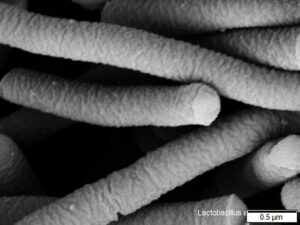
From Wikimedia
Pediococcus spp.
This genus contain Gram-positive homofermentative bacteria usually occurring in pairs or tetrads. It increases viscosity by producing excessive glucans in beer and wine.
Streptococcus spp.
These non-spore-forming Gram-positive, anaerobic facultative bacteria play an important role in the fermentation industry. These bacteria are non-motile, don’t produce endospores, and can survive at 35-42°C. in contrast to pathogenic bacteria species, Streptococcus thermophiles is responsible for the fermentation of dairy products. In addition, it lowers the bitterness of the cheese with minimum moisture.
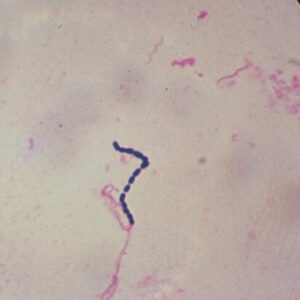
From Wikimedia
Lactococcus spp.
This genus is extensively used in the dairy industry due to its homofermentative metabolism. These bacteria are capable of producing both isomers of lactic acid, however, D- isomer is produced only at low pH. They are Gram-positive, nonmotile cocci bacteria, often found in chains. Eg. Lactococcus lactis.

From Wikimedia
Leuconostoc spp
This genus is Gram-positive heterofermentative anaerobic bacteria which produces dextran from sucrose. Eg. Leuconostoc carnosum. It is present in vacuum-packed, chilled meat items results in souring and slime formation.
Kurthia spp
Kurthia belongs to the genus of coryneform bacteria predominantly associated with unpleasant taste, foul smell and taints of both processed and fresh meat. They are aerobic bacteria often appear in chains or rods. Eg. Kurthia zopfiienus
Weissella spp.
Weissella is a Gram-positive non-endospore forming bacteria belonging to the group of LAB. They inhabit in variety of foods such as milk, vegetables as well as other fermented foods. Eg. Weissella minor produces either D-lactic acid or a mixture of D (-)- and L (-)- lactic acid and acetic acid along with CO2 after carbohydrate metabolism.
The spore-forming spoilage bacteria examples are as follows:
Spore-former bacteria group are dominated by two major groups namely the aerobic Bacillus species and the anaerobic Clostridium species. The family Bacillaceae includes wide range of bacteria starting from mesophiles, psychrotrophs and thermophiles inhabiting in extreme environmental conditions.
Clostridia is a well-known bacterial class including both pathogenic and non-pathogenic bacteria. They are obligate anaerobes and involved in spoilage of canned foods. They release characteristic bad smell due to the formation of butyric acid by as a by-product during fermentation. They undergo anaerobic proteolysis resulting in putrefaction of the food.
Bacillus sporothermodurans
This bacterium produces heat-resistant spores that can withstand high-temperature and industrial sterilization processes. The spores are found in thermally treated dairy products (whole, skimmed and evaporated milk) and also in milk powders.

From Wikimedia
Bacillus amyloliquefaciens
This bacterium is closely related to Bacillus substilis and share homologous genes. They occur in the summer at 25°C and 30°C with pH 5-9. B. amyloliquefaciens contamination in bread is often characterized by unpleasant fruity smell along with soft, sticky texture resulting it inedible.
Geobacillus stearothermophilus
Geobacillus stearothermophilus is a thermophilic spoilage bacterium which produces acids but doesn’t release any gas during contamination. These bacteria can survive at elevated temperature ranges from 50°C to 55°C with pH around 5.3 by synthesizing heat-tolerant enzymes and proteins. Since they are tolerant to high temperatures thus it causes significant damage to pasteurized milk and other dairy products.
Bacillus coagulans
This bacterium is able to grow at lower pH (below 4.0) which compels it to thrive as a facultative anaerobe, thermotolerant and acidophilic bacteria. They are readily found in canned vegetables and cause severe acidification of food items referred as ‘flat sour spoilage’ due to lactic acid formation without any traces of gas.
Alicyclobacillus acidoterrestris
This bacterium is an obligate acidophile which grows substantially at low pH ranges from 2.5 to 5.5 and at temperature 25°C to 60°C. The spores are more resistant to heat as compared to other spore-formers. They cause extensive spoilage of processed canned fruits and vegetables and even escapes pasteurization.
Clostridium butyricum
These are butyric anaerobes frequently associated with spoilage of canned foods with pH values ranges from 3.9-4.5.
Clostridium sporogenes
They are anaerobic, rod-shaped bacterium often found in long chains. It plays an important role in food spoilage. This bacterium typically produces burst packs with a strong foul unpleasant smell. They inhabit in variety of places such as soil, marine and freshwater environment and also in preserved meat and dairy products. They are closely linked to malicious bacterium C. botulinum phylogenetically.
Clostridium putrefaciens
These bacteria are a major concern in ham curing industry because it can thrive in 4% NaCl as well as 100 ppm NaNO2 solution. They are anaerobes, mesophilic bacteria which liberate characteristic smell from meat along with softening of the meat.
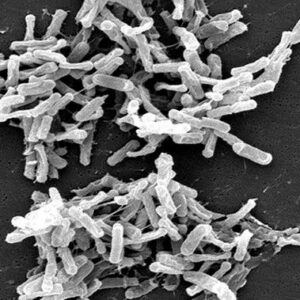
From Wikimedia
Desulfotomaculum nigrificans
These are thermophilic polyphyletic spore forming bacteria. Its contamination results into blackened product of canned sweet corn, after reacting with H2S produced by the bacteria.
Besides non-pathogenic bacteria, some pathogenic bacteria are also involved in food spoilage. The spoilage bacteria examples are Brucella spp., Campylobacter spp., Salmonella spp., and Escherichia spp.
Brucellae spp.
These are a group of Gram negative non-sporing bacteria. Effective pasteurization reduces Brucella spp count significantly in dairy products. However optimal pH (6.6-7.4) also influences its growth and proliferation. The contamination in human spreads after consumption of unpasteurized and uncooked meat.
Campylobacter spp.
They require temperature of around 41°C and pH of about 6.5-7.5 to thrive outside the host bodies.
Salmonellae spp.
These are another pathogenic group of facultative anaerobic bacteria responsible for foodborne outbreaks. These are Gram-negative, rod-shaped bacteria. Salmonella enterica and S. bongori are the two most important bacteria of this group responsible for spoilage.
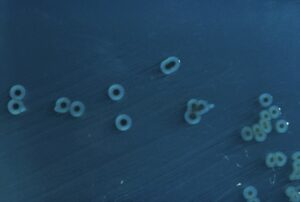
From Wikimedia
Escherichia spp.
This genus is characterized by Gram negative, non-spore formers, facultative anaerobic bacteria. Thermal processing can reduce the contamination substantially. Escherichia coli is a common food spoilage bacterium with pathogenicity.
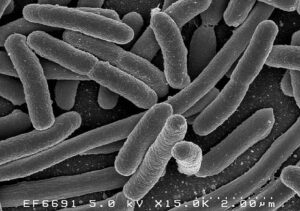
From Wikimedia
What are spoilage bacteria?
This group comprises a wide range of bacteria that are present in various processed chilled foods like meat and dairy products and undergoes characteristic metabolic processes such as proteolysis and putrefaction along with distinct spoilage attributes.
Spoilage bacteria are single-celled microorganisms. Spoilage is dictated by the type of bacteria and its requirements required to survive. It is also dependent upon the intrinsic and extrinsic factors of the food and storage conditions.
Also Read:
- Dna replication vs polymerase
- Do prokaryotes have telomeres
- Amensalism examples
- Dispersive dna replication
- Photosynthesis in cytoplasm
- Do animal cells have endoplasmic reticulum
- Atp synthesis stages
- What happens to a cell in a hypotonic solution
- Does fermentation occur in the mitochondria
- Function of cytosine

I am a doctoral student of CSIR- CIMAP, Lucknow. I am devoted to the field of plant metabolomics and environmental science. I have completed my post-graduation from the University of Calcutta with expertise in Molecular Plant Biology and Nanotechnology. I am an ardent reader and incessantly developing concepts in every niche of biological sciences. I have published research articles in peer-reviewed journals of Elsevier and Springer. Apart from academic interests, I am also passionate about creative things such as photography and learning new languages.
Let’s connect over Linkedin